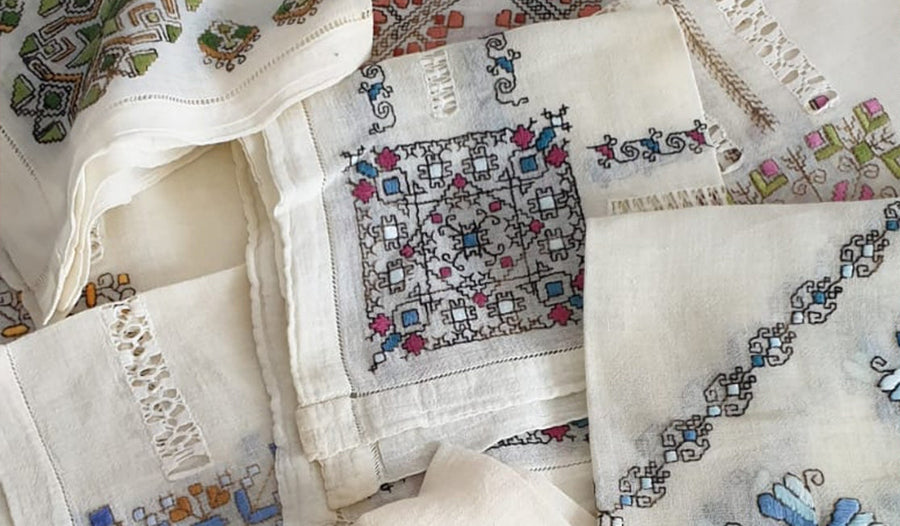
What can the humble hankie tell us about European history?
We were incredibly lucky that Gillian Vogelsang-Eastwood of TRC Leiden recently took part in our Textile Tokens talk and was able to enlighten us on the history of the handkerchief as a token imbued with meaning rather than a practical item. From specific ways they were carried and bestowed to convey romantic, political or even economic meaning, to the many ways in which they were folded, it's clear that these small pieces of textile are themselves imbued with memory, identity and creativity. Read on for Gillian's blog about the latest handkerchief collection recently acquired by the Textile Research Centre, Leiden.
 Image: Beige handkerchief. Bobbin lace in torchon technique mounted on square cloth. Lace pattern consists of diagonal blocks with flowers and leaves. TRC 2007.0659
Image: Beige handkerchief. Bobbin lace in torchon technique mounted on square cloth. Lace pattern consists of diagonal blocks with flowers and leaves. TRC 2007.0659
On Wednesday 10th November I gave an online talk about European ‘Handkerchiefs as tokens’ for Selvedge, the London based textile magazine. It’s a subject I am interested in, but never had the time to go into in any depth. While preparing the talk I remember thinking that we only had a relatively small collection of late 19th and 20th century handkerchiefs at the TRC and I really wanted to know more about their full history, variations and indeed, even how many different ways are there to fold handkerchiefs?
I should not have expressed such thoughts! We have just been given a large shopping bag full of handkerchiefs, more than 150, many of them in their original boxes (for example, TRC 2021.3394), and yes, folded in a variety of different ways, for both display purposes and practical use.

Image: 20th century red cotton handkerchief with the image of a woman wearing a half hat veil sitting at a table with various items. TRC 2021.3410
The handkerchiefs range in date from about 1900 to the 1960s. The donation includes handkerchiefs that had been used, as well as others that seem to be purchasing models (with numbers for re-ordering), as well as general shop stock including several of the same type. Not to mention, of course, a range of identically decorated handkerchiefs, but in different colour ways.
Although we have only just started working on these items, several points may already be highlighted, including the range of materials being used, namely fine silk, linen, and cotton, different sizes, including token handkerchiefs, children’s, women’s and men’s forms, but also with different methods of decoration (woven, printed, hand embroidered, machine embroidered, lace, as well as combinations of these techniques). There is also a wide range of designs. Some of them are very artistic, others quite plain, and, of course, with many origins – Dutch, French, Irish, Swiss, etc.

Image: 20th century red cotton handkerchief with the image of a woman wearing a stylish evening dress with long black gloves. TRC 2021.3409
One group of handkerchiefs has an intriguing history. The group consists of four red examples. Two of them (TRC 2021.3407 and TRC 2021.3408) have the text ‘Pour le rouge’ and the other ‘Pour vous Madame!’ (TRC 2021.3409 and TRC 2021.3410).
Red handkerchiefs of this type are said to have been introduced for women in the 1930s, perhaps by Hollywood stars such as Joan Crawford who wore bright red lipstick. The lipstick would come off and stain white handkerchiefs in an unattractive manner. Hence handkerchiefs were produced in various shades of red that would hide the lipstick stains! Apparently, red handkerchiefs remained popular, within certain circles, well into the 1960s.
More handkerchief stories to come in due course!
Written by Gillian Vogelsang-Eastwood, TRC Leiden
--
Visit the TRC Leiden website: www.trc-leiden.nl
From pockets, where small belongings could be stored, carried and even hidden, to the immensely evocative textile tokens handed by a mother with a child to The Foundling Hospital, textiles have consistently been treasured and protective tokens, imbued with memory, identity and creativity.
We were thrilled that Gillian took part in our Textile Tokens talk alongside Ariane Fennetaux, John Styles and Megan Griffiths. Find out how you can access the full online talk here:



1 comment
I, too, have a hanky collection. It was a tradition in my family, here in the Midwest of America, to give each other hankies for birthdays and Christmas. They would be included in greeting cards. I have hankies from when I was a little girl (I’m 71, now) that have the day of the week on them. I have the hanky that my mom used to blot her lipstick, not long before she died. It has her “lip-print” on it, and I cherish it. I keep them in a drawer, and take them out now and then and think about the memories they bring me. I use them when we go out for the evening – much nicer than wiping one’s nose with a Kleenex!! I love my hankies…